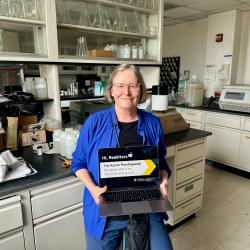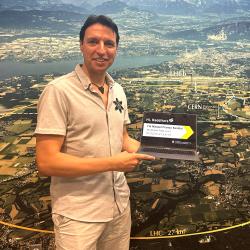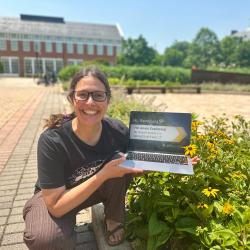Meteorologist Daile Zhang Answers Questions About Lightning
The College of Computer, Mathematical, and Natural Sciences hosted a Reddit Ask-Me-Anything for Lightning Safety Awareness Week.

Daile Zhang, an assistant research scientist at the University of Maryland’s Earth System Science Interdisciplinary Center, participated in an Ask-Me-Anything (AMA) user-led discussion on Reddit to answer questions about lightning.
A lightning physics specialist, Zhang’s research focuses on evaluating lightning data from ground-based and satellite-based networks. She and Ronald Holle published an educational booklet called "So You Think You Know Lightning" in 2017 and a Springer book "Flashes of Brilliance: The Science and Wonder of Arizona Lightning" in 2023. This year, Zhang took the lead in organizing the 2024 International Lightning Safety Day event to mitigate lightning hazards worldwide.
This Reddit AMA has been edited for length and clarity.
How far can lightning travel from the storm it originates from?
Some stratiform lightning can travel a couple of tenths of miles/kilometers from the origin of the storm. These are lightning called 'bolt from the blue.' The world record for the longest distance that lightning has traveled is 477 miles.
Why do some storms have mostly sheet lightning or cloud-to-cloud lightning, as opposed to lightning strikes?
Two-thirds of lightning flashes are within a cloud instead of reaching the ground. The lightning inside a cloud originates from the negative-charged layer in the middle of the cloud to the upper-level positive-charged layer. The cloud-to-ground strikes are from the negative-charged layer in the middle towards the ground. The ratio of these in-cloud lightning has to do with the relative location of the charged layers and the size of the charged center. Also, the environmental temperature makes a big contribution to the height of the charged layer. Within a single storm evolution, the intra-cloud lightning is more often during the initial/developing stage of the storm. The cloud-to-ground lightning is more often during the mature/dissipating stage of the storm.
What are the most dangerous places for being struck by lightning? What would you do to prevent it if you found yourself in one of those places during a storm?
In the U.S., the activities/locations where people are more likely to be in danger of being struck by lightning are fishing or under trees or up on the roof or playing golf. Being outside during a thunderstorm is dangerous regardless of what you're doing. Geographically, Florida and Texas have more lightning fatalities because they have more lightning (and they have a larger population).
When thunder roars, go indoors! Or go into your car (with windows and doors closed) if you can't find a big building. You have to have a metal surface to divert the current, so a typical convertible-style roof would not suffice.
Does the height of buildings have a relevant impact on the frequency of lightning strikes and/or does modern architecture and electrical safety standards (such as grounding cables) essentially make streets safe from lightning strikes by virtue of all the buildings being safe grounding targets?
It's definitely not safe to stand in a street in a large city during a thunderstorm. Isolated tall buildings or objects can be more attractive to lightning, but lightning does not always strike the tallest building. For those modern buildings with grounding cables, if you are inside those buildings, you are safe. But being outside on the street next to one of those buildings is still not safe.
Are lightning rods effective at mitigating strikes?
No. Lightning rods divert lightning currents to the ground so that the current doesn't go into the building, to keep people in the building safe. But lightning rods don't mitigate or decrease lightning strikes. The charge rate depends on microphysics, temperature, humidity, terrain, etc., not the presence of a lightning rod. That said, lightning rods are important for protecting people from being struck by lightning; if you're inside the building, a lightning rod will help protect you.
What happens when lightning strikes a person wearing sneakers vs. someone who isn't wearing anything on their feet? Do sneakers prevent electricity from passing to the ground? Which person gets harmed more?
A thin layer of sneakers/rubber-soled shoes will not prevent you from getting struck by lightning. The lightning current is too strong. There is no difference in the level of harm from a lightning strike between someone wearing sneakers vs. someone not wearing shoes.
My 7-year-old asks if passengers in an airplane that is going through a lightning storm are safe, and if so, why?
Yes, it is safe to be on a plane during a lightning storm. There are a lot of cases where a commercial plane was struck by lightning but still flew to its destination without any issues. This is because the metal exterior of the plane can divert the current to the atmosphere, so you're safe inside the plane. However, the lightning could damage the electronics or exterior of the plane, so these planes definitely need inspections and maintenance after getting struck by lightning.
I've heard talks about producing energy by capturing lightning. How feasible is this theoretically? What are the hurdles? And how far are we, practically speaking, to making it viable, if possible?
Collecting and using the energy from lightning is not feasible. Because the location of a lightning strike is unpredictable, it is uncertain where to put a "container." No container can withstand such a short powerful surge and then store this energy without it being "lost." Lightning transfers both positive and negative charges. Even if we had a way to collect the energy, the opposite charges would tend to neutralize each other.
A couple of years ago a new category of lightning was identified—the ones from the cloud to the higher levels of the atmosphere. What do we now know about them?
That's the TLE (transient luminous event) lightning. TLEs are very fast, so usually you can't see them with your naked eyes. They are usually associated with very intense cloud-to-ground lightning (either negative or positive). Some of the gigantic jets are usually produced in very large thunderstorms in coastal regions. We recently have advanced technology to observe them, so we're better able to study these events.
What are some unsolved problems in your field? What is the holy grail of lightning research? What would a breakthrough look like and how might it change how we understand/react to storms?
That's a big question! Believe it or not, within the lightning community, we aren't in agreement about what a lightning flash is. We don't know about lightning initiation, and we're still trying to see how the lightning activity could affect climate, and vice versa.
Something I would be interested in is the atmospheric electricity or electric field and its impact on the biosphere (animals, humans, plants).







